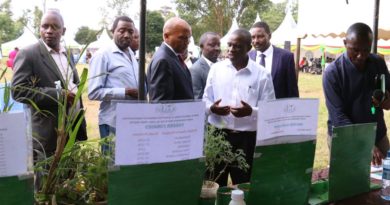Ministry of Agriculture Collaborates With USAID, FAO in Training Vets
From kilimo.go.ke
The Ministry of Agriculture in collaboration with United States Agency for International Development (USAid) and Food and Agriculture Organization (FAO) has initiated a training program for veterinary officers on new surveillance, detection and management techniques of transboundary animal diseases. Principal Secretary State Department for Livestock, Harry Kimtai said in Sub-Saharan Africa where livestock production accounts for 25 per cent of economic activity, diseases such as East Coast Fever (ECF), Rift Valley Fever (RVF) and foot and mouth threaten livelihoods and food security.
Speaking in Nakuru when he inaugurated the training, the first one of its kind in the country for the first batch of 25 veterinary officers, Mr Kimtai observed that those mostly impacted on are pastoral communities who rear herds of cattle and goats for livelihoods. “They move from one place to another in search of pasture and water, often this increases the transmissibility of these diseases in savannas and forests. Some of the diseases are zoonotic, which means they can jump from animals to humans,” he added. The Principal Secretary was accompanied by County Executive Committee Member for Agriculture, Fisheries and Livestock Dr. Immaculate Maina, FAO Country Representative Ms Carla Mucavi and USAid Regional Advisor Mr Ricardo Echalar. The month-long venture is dubbed “Frontline in service applied veterinary epidemiology training program.”
Mr Kimtai said diseases such as Pasteurella (pulpy kidney), Enterotoxaemia (haemorrhagic septicemia) and anthrax have a huge impact on cattle and small ruminant production and were among the most destructive trans-boundary diseases in the region. “The spread of trans-boundary diseases has increased dramatically in recent years. The rapid increase in their spread which is posing new challenges has been attributed to globalization, trade and climate change, as well as reduced resilience in production systems due to decades of agricultural intensification. Equipping veterinary officers with modern skills on surveillance, detection, treatment and management of transboundary diseases is expected to check their spread, improve food security and nutrition and increase household incomes in Kenya,” he stated.
He indicated that Kenya was witnessing new trans-boundary diseases that have been spreading from other countries through trade or other human-migrated movements, environmental forces such as water, weather and windborne and insect or other vector-borne pathogens. Mucavi noted that 75 per cent of diseases afflicting human beings have their origins in animals. She said a multi sectoral approach bringing on board specialists in agriculture, health and environment was necessary to contain diseases that can be spread to humans from animals. The FAO Country Representative said that though some of the well-known zoonotic ailments such as tuberculosis, rabbit fever, rabies, Toxocariasis, HIV/Aids among others had been around for centuries, new ailments were emerging due to environmental changes and increased human interaction through local and international travel.
Echalar indicated that strengthening the capacity to control and manage animal diseases was key to protecting the livelihoods of those who depend on livestock. He added that frequent outbreaks of livestock diseases have slowed down the region’s efforts to access lucrative international dairy and meat products markets. USAid Regional Advisor noted climate change that has resulted in prolonged droughts or dry spells in most parts of the country has led to a growing number of livestock keepers to encroach on protected areas like national parks or game reserves in search of pastures and water for their animals. “This enhances the interaction between wild animals and cattle which promotes disease transmission. Some of the shared diseases between livestock and wild animals include malignant catarrhal fever (MCF) and rabies,” he added.
Dr.Maina said transboundary diseases not only represent a high to moderate risk to the food chain in Kenya but also posed a serious threat to lives of livestock keepers and consumers of dairy and beef products. “Animal diseases lower milk and beef yields hence causing massive losses to many households that rely on livestock to sustain their livelihoods. And some of these ailments are also zoonotic diseases such as anthrax, rabies and RVF that can affect human beings leading to severe health problems,” she added. Aside from contributing to food insecurity, Dr. Maina noted that disease outbreaks result in imposition of disease-related export restrictions that further undermine the country’s economy.
She said her department was jointly working with stakeholders to establish effective surveillance approaches, integrated management procedures, farmer training and capacity building towards tackling transboundary diseases. Between 2006 and 2007, the RVF- a mosquito-borne disease claimed the lives of 150 people in Kenya and caused losses worth Sh3.42 billion in livestock deaths, reduced animal productivity and trade bans on the animals and related products. According to the World Health Organization (WHO), Outbreaks of the disease in Africa are associated with periods of above-average rainfall. The highly infectious disease can also be transmitted through close contact with contaminated animals’ blood or organs.
With no specific treatment or effective human vaccine, Rift Valley fever can cause blindness and severe hemorrhaging, leading the victim to vomit blood or even bleed to death. In March, the RVF affected two pastoral counties of Isiolo and Marsabit, claiming some animals and human lives. As of February, this year, there were a total of 32 human cases (14 confirmed positive and 11 deaths) according to the World Health Organization.
During the last major outbreak of RVF in Kenya between November 2006 and March 2007, more than 234 people died and hundreds were hospitalized in the northeastern part of the country.




